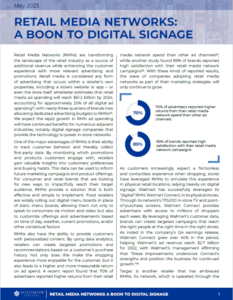 Retail Media Networks: A Boon to Digital Signage
Retail Media Networks: A Boon to Digital Signage
Retail Media Networks (RMNs) are transforming the landscape of the retail industry as a source of additional revenue while enhancing the customer experience with more relevant advertising and promotions. Retail media is considered any form of advertising that occurs within a retailer’s own properties, including a store’s website or app – or even the store itself. eMarketer estimates that retail media ad spending will reach $61.2 billion by 2024, accounting for approximately 20% of all digital ad spending (1), with nearly three-quarters of brands now allocating dedicated advertising budgets to RMNs (2). We expect the rapid growth in RMN ad spending will have continued benefits for numerous adjacent industries, notably digital signage companies that provide the technology to power in-store networks.
One of the major advantages of RMNs is their ability to track customer behavior and thereby collect first-party data. By monitoring which promotions and products customers engage with, retailers gain valuable insights into customers’ preferences and buying habits. This data can be used to inform future marketing campaigns and product offerings. For consumer and retail brands that are looking for new ways to impactfully reach their target audience, RMNs provide a solution that is both effective and simple to implement. Food retailers are widely rolling out digital menu boards in place of static menu boards, allowing them not only to speak to consumers via motion and video, but also to customize offerings and advertisements based on time of day, weather, current promotions, and/or other contextual factors.
RMNs also have the ability to provide customers with personalized content. By using data analytics, retailers can create targeted promotions and recommendations based on a customer’s purchase history. Not only does this make the shopping experience more enjoyable for the customer, but it also leads to a higher and more measurable return on ad spend. A recent report found that 70% of advertisers reported higher returns from their retail media network spend than other ad channels (3), while another study found 89% of brands reported high satisfaction with their retail media network campaigns (2). With these kinds of reported results, the wave of companies adopting retail media networks as part of their marketing strategies will only continue to grow.
As customers increasingly expect a frictionless and contactless experience when shopping, stores have leveraged RMNs to simulate this experience in physical retail locations, relying heavily on digital signage. Walmart has successfully leveraged its “digital” RMN, Walmart Connect, in its physical stores. Through its network’s 170,000 in-store TV and point-of-purchase screens, Walmart Connect provides advertisers with access to millions of shoppers each week. By leveraging Walmart’s customer data, brands can create targeted campaigns that reach the right people at the right time in the right stores. As noted in the company’s Q4 earnings release, Walmart Connect grew over 40% in the period, helping Walmart’s ad revenue reach $2.7 billion for 2022, with Walmart’s management affirming that “these improvements underscore Connect’s strengths and position the business for continued growth.” (4)
Target is another retailer that has embraced RMNs. Its network, which is operated through the subsidiary company Roundel, provides customers with personalized content and recommendations based on their shopping behavior, both on its e-commerce platform and physically through a network of digital screens. Roundel drove more than$1 billion in value in 2021 and the company expects that figure to double over the next couple of years, citing growth over 60% in the last two years as a driver for its continued investment to the platform (5). In addition to displaying ads from over a thousand brand partners, Target has also used its network to promote its own products, resulting in increased sales and brand awareness.
Kroger is another retailer that has seen success with its RMN. Its network, Kroger Precision Marketing, provides brands sold in stores access to Kroger’s customer data, allowing them to create targeted campaigns that drive sales. Since the network’s inception in 2017, Kroger spun off the division into a separate company, which generated a large portion of Kroger’s $1.2 billion in operating profit from alternative businesses in 2022 (6). In late 2021, Kroger also announced a private programmatic advertising marketplace and rolled out the 84.51° Collaborative Cloud platform that puts transaction-level data into a privacy-compliant hosted environment.
As RMNs continue to gain traction in the retail industry, the digital signage industry as a whole is likely to benefit from the shift toward this new model. Retailers will look for more sophisticated solutions that provide personalized content and valuable data, while advertisers will be eager to tap into the vast audience that these networks provide. Whether through additional demand for existing technology such as digital menu boards or QR codes, or new, interactive technologies such as AI and virtual reality, the rise of RMNs will continue to drive demand for digital signage and other in-store and online media and tech services solutions.
Click below to read the article from the Media Group.
1. Insider Intelligence Trends, Forecasts & Statistics; 2. The Trade Desk; 3. McKinsey & Company; 4. Walmart; 5. Target; 6. Kroger
Read the Article


